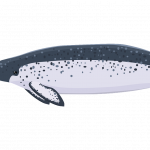Rabies is a disease that can be contracted by a variety of marine mammals, including dolphins, and passed on to other marine mammals. On the other hand, the possibility of rabies spreading to a dolphin is extremely remote. Given that dolphins are marine mammals, the possibility of them being bitten by an animal that lives on land is extremely remote and statistically insignificant. Even so, a dolphin can get rabies if another marine mammal that already has it, like a walrus, seal, sea lion, or any of the other marine mammals, bites it.
Can Dolphins Get Rabies?
Dolphins have a very low risk of contracting rabies, but the disease could be transmitted to them if they get into a fight with another animal that has rabies or if an infected animal bites them. The following is a list of some of the defenses that dolphins have against the disease:
- The area on land where dolphins are most likely to be bitten by humans is avoided by the dolphins
- The scaly texture of a dolphin’s skin acts as an additional barrier against the spread of disease
- Rabies is only contagious among an extremely limited number of marine animals.

How Can Dolphins Catch Rabies?
In order for this to take place, another animal that lives on land must first infect the dolphins or any other marine animal with rabies. Rabies can then be passed on to the dolphins. Rabies-infected animals and the vast majority of marine animals do not live in close proximity to one another.
Even if fights between animals do take place, an animal would have to pierce through the thick layer of skin that covers the dolphin in order to introduce the disease into the bloodstream of the dolphin.
The fact that it is such a challenging task to complete probably contributes to the disease rate among dolphins remaining extremely low.
Although there is a possibility that dolphins will be harmed directly by a land animal, the likelihood of this happening is low because land animals typically do not live in or around the seas and oceans.
Even those that are found in close proximity to the water will not travel such a great distance for the sole purpose of attacking or biting a dolphin.
How Would Rabies Affect a Dolphin?
Rabies is a disease that, if left untreated, can develop into a very serious form of encephalitis. Before the disease even reaches the brain of its host, it may have already been present for several months.
Unfortunately, if it is allowed to progress unchecked and reach the brain, there is an extremely high risk of death. The ease with which rabies can be passed from one animal species to another, most frequently through the transmission of a bite, is one of the primary factors that contributes to the disease’s lethality.
Therefore, it is possible for one species of mammal to have an effect on another species of mammal and so on.
Because dolphins are not built to attack one another, even in the extremely unlikely event that one of them contracts rabies, it is extremely unlikely that it will be passed on to other dolphins because dolphins do not typically interact aggressively with one another.
The killer whale is one of the primary species that has the potential to, in some instances, transmit the rabies virus to other marine mammals. It is common knowledge that these whales will hunt, attack, and consume other marine mammals such as dolphins, sea lions, whales, and seals.
However, because dolphins consume other fish, squids, and crustaceans such as shrimp, if they are infected with rabies, they have the potential to pass it on to others.
However, it is important to note that the likelihood of this happening is quite low. In addition to this, there is yet another caveat regarding the transmission of rabies to fish and other animals.
The disease known as rabies is a distinct condition that does not typically affect animals with a cold-blooded metabolic system, such as fish and sharks. But it is possible for others to obtain it.

Could a whale get rabies?
The most common animals to carry rabies are bats, coyotes, foxes, and raccoons. However, due to their terrestrial lifestyles, it is extremely unlikely that any of these animals would ever have the opportunity to bite and infect a whale.
However, if one of those animals were to bite a seal while it was relaxing on the beach, the seal might then swim away and bite a whale. Despite the fact that there is not a single documented case of rabies in a whale and only one documented case of rabies in a seal (which occurred in a ringed seal that was caught in 1980 in Svalbard, which is an archipelago off the coast of Norway), the scenario may soon be of greater concern.
Even if a rabid seal bit a whale, it could take years for the whale to show any symptoms of the disease. It is necessary for the virus to travel along a nerve from the site of the bite to the central nervous system and the brain in order for infection to occur.
Because of this, a person who is bitten by a rabid fox in the face will show symptoms sooner than if they have been bitten in the foot by the same fox.
Since the rabies virus moves along nerves at a rate of 0.3 to 0.8 inches per day, it is possible that it could take two to five years for the virus to reach the animal’s brain and begin to manifest itself if a whale that is 50 feet long was bitten in the tail.
Do sea mammals get rabies?
Yes, some marine mammals can get rabies. However, the official statistics don’t suggest that sea lions, harbor seals, dolphins, or walruses are likely candidates for the rabies virus. Walruses are the only marine mammals that can swim backward.
However, because marine mammals and humans share the same world of microbes, it is possible for us to exchange pathogens such as bacteria, viruses, and fungi.

Are Seals Dangerous to Humans?
Seals pose no threat to human beings because they almost never attack their own. In most cases, seals will not attack humans on purpose and seemingly out of nowhere without any provocation. Even though there have been a few reports of seal attacks, the incidence of such incidents is extremely low.
Even though seals may bite, their bites can not be fatal because they are not venomous and do not carry rabies. Despite the fact that seals may bite, they are not dangerous.
Even though seals are mammals, they very rarely become infected with rabies. This is due to the fact that rabies is more commonly found in land mammals.
However, seal bites can spread infections, most notably the infamous “seal finger” condition that is a common consequence of seal bites.
Even though seals live in the water, they are mammals just like humans, which means that their bites can spread diseases like herpes and other viruses and bacteria.
When bitten by a seal, one of the most significant dangers you face is the possibility of contracting zoonosis, an infection that can be passed from animal to human.
What happens if a whale gets rabies?
Rabies, however, has the same effect on whales as it does on other animals. Because it disrupts any activity that is dependent on the central nervous system, a whale infected with rabies may exhibit abnormal swimming patterns or lose the ability to swim altogether.
It’s possible that it has issues with echolocation, as well. Be wary, then, of whales that swim in a zigzag pattern and may collide with objects. Another classic symptom of rabies infection is hydrophobia, which is a fear of water. This condition would be extremely challenging for a whale to manage.
Are Otters Capable of Transmitting Rabies to Humans?
Otters and their potential attacks have been a topic of concern for many, but when it comes to rabies transmission, there is good news. According to experts, otters are not known to transmit rabies to humans. While otters can bite if threatened, the risk of contracting rabies from them remains low. However, it is always recommended to avoid direct contact with wild animals and report any unusual behavior observed in otters or other wildlife to the relevant authorities.
Can Hippos be considered as Marine Mammals Since They Live in Water and on Land?
Hippos, despite their aquatic lifestyle, are not categorized as marine mammals as they primarily inhabit freshwater bodies like rivers and lakes. While they spend a significant amount of time in water, their natural habitats extend to land as well. Thus, hippos’ natural habitats include both aquatic and terrestrial environments.
Are Dolphins Considered Annoying Animals?
Dolphins are highly intelligent and sociable creatures, known for their playful behavior and interactions with humans. They possess a range of vocalizations, which some might find annoying, but overall, they are far from being considered the most annoying animals in the world. Dolphins are admired for their beauty and grace, often captivating people with their acrobatic displays and fascinating abilities.
Can platypuses get rabies?
Never in a million years. Platypuses are only found in Australia, which is also the only place where rabies does not exist. Platypuses cannot contract rabies because their internal temperatures are too low; it is believed that any mammal with a warm-blooded system is susceptible to contracting rabies. They have a body temperature of 32 degrees Celsius on average, whereas the majority of mammals have a body temperature that ranges between 37 and 38 degrees Celsius.








